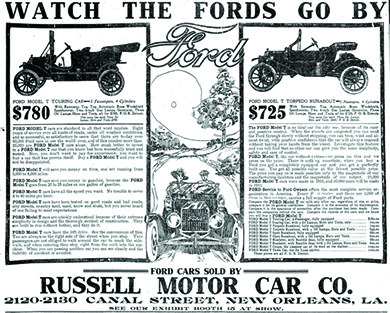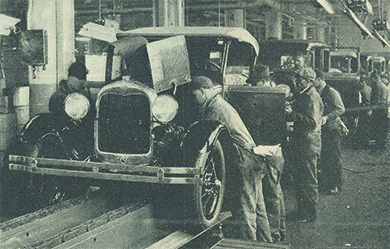| << Chapter < Page | Chapter >> Page > |
Cinema was not the only major industry to make great technological strides in this decade. The 1920s opened up new possibilities of mobility for a large percentage of the U.S. population, as automobile manufacturers began to mass produce what had once been a luxury item, and daring aviators both demonstrated and drove advancements in aircraft technology. The most significant innovation of this era was Henry Ford’s Model T Ford, which made car ownership available to the average American.
Ford did not invent the automobile—the Duryea brothers in Massachusetts as well as Gottlieb W. Daimler and Karl Friedrich Benz in Germany were early pioneers. By the early twentieth century, hundreds of car manufacturers existed. However, they all made products that were too expensive for most Americans. Ford’s innovation lay in his focus on using mass production to manufacture automobiles; he revolutionized industrial work by perfecting the assembly line, which enabled him to lower the Model T’s price from $850 in 1908 to $300 in 1924, making car ownership a real possibility for a large share of the population ( [link] ). As prices dropped, more and more people could afford to own a car. Soon, people could buy used Model Ts for as little as five dollars, allowing students and others with low incomes to enjoy the freedom and mobility of car ownership. By 1929, there were over twenty-three million automobiles on American roads.

The assembly line helped Ford reduce labor costs within the production process by moving the product from one team of workers to the next, each of them completing a step so simple they had to be, in Ford’s words, “no smarter than an ox” ( [link] ). Ford’s reliance on the moving assembly line , scientific management, and time-motion studies added to his emphasis on efficiency over craftsmanship.

Ford’s emphasis on cheap mass production brought both benefits and disadvantages to its workers. Ford would not allow his workers to unionize, and the boring, repetitive nature of the assembly line work generated a high turnover rate. However, he doubled workers’ pay to five dollars a day and standardized the workday to eight hours (a reduction from the norm). Ford’s assembly line also offered greater equality than most opportunities of the time, as he paid white and black workers equally. Seeking these wages, many African Americans from the South moved to Detroit and other large northern cities to work in factories.
Ford even bought a plot of land in the Amazonian jungle twice the size of Delaware to build a factory town he called Fordlandia . Workers there rejected his midwestern Puritanism even more than his factory discipline, and the project ended in an epic failure. In the United States, however, Ford shaped the nation’s mode of industrialism—one that relied on paying decent wages so that workers could afford to be the consumers of their own products.

Notification Switch
Would you like to follow the 'U.s. history' conversation and receive update notifications?